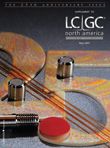Corporate Retrospective 2007: MicroSolv
Since its inception, LC Magazine and LCGC North America has supported MicroSolv Technology Corporation's evolution from an "idea" by the sales and marketing team of the former, ACE Scientific Supply Co., Inc., to the present international company which it is today.
Since its inception, LC Magazine and LCGC North America has supported MicroSolv Technology Corporation's evolution from an "idea" by the sales and marketing team of the former, ACE Scientific Supply Co., Inc., to the present international company which it is today.

From this "original" idea, Scientific Resources, Inc. (SRi) was created in 1988 with the dual focus of selling consumables and entering the emerging technology market of capillary electrophoresis (CE). In 1992, SRi created a new and separate product line for CE and named it MicroSolvCE.
In 1997, the MicroSolvCE product line was spun off by SRi and incorporated as a separate company. Early efforts of the new company were directed toward basic research and development of unique technology for open tubular CE and new, evolutionary HPLC stationary phases. Working in conjunction with university faculty and MicroSolv's technical staff, many new and unique products, most notably the TYPE-C silica-hydride HPLC columns, were introduced to the separation science industry with the majority of these first announced to the market through LCGC.
Today, MicroSolv continues to specialize and develop new and exciting products for micro-scale techniques such as: CE, OTCEC, pCEC, capillary LC and "evolutionary" HPLC columns and consumables. In 2007, a strategic alliance was formed with Unimicro Technologies to market a new, innovative instrument that performs CE, pCEC, and capillary LC separations. Together, we will continue to be a part of the industry that LCGC has served so well for the last 25 years. We look forward to celebrating LCGC's 50th anniversary!

Bill Ciccone
Bill Ciccone
MicroSolv Technology Corporation

Determining Neurotransmitters in Spinal Cords with UHPLC
February 18th 2025Researchers at Jilin University (Changchun, China) developed a highly sensitive, rapid, and accurate method for analyzing neurotransmitters (NTs) in rat spinal cord tissue. Ultra-high performance liquid chromatography-triple quadrupole tandem mass spectrometry (UHPLC-QqQ-MS/MS) in conjunction with ultra-ionic liquid dispersive liquid-liquid microextraction (UA-MIL-DLLME) were used to extract NTs for analysis.
The Next Frontier for Mass Spectrometry: Maximizing Ion Utilization
January 20th 2025In this podcast, Daniel DeBord, CTO of MOBILion Systems, describes a new high resolution mass spectrometry approach that promises to increase speed and sensitivity in omics applications. MOBILion recently introduced the PAMAF mode of operation, which stands for parallel accumulation with mobility aligned fragmentation. It substantially increases the fraction of ions used for mass spectrometry analysis by replacing the functionality of the quadrupole with high resolution ion mobility. Listen to learn more about this exciting new development.
Revolutionizing LC-MS with Next-Gen Separation for Cyclic Peptide Analysis
February 17th 2025Cyclic peptides, known for their stability and high specificity, are promising therapeutic agents in the fight against cancer, infections, and autoimmune diseases. However, developing effective cyclic peptides presents numerous challenges, including poor pharmacokinetics, efficacy, and toxicity. Traditional methods like liquid chromatography tandem-mass spectrometry (LC-MS/MS) often struggle with resolving isomeric linear peptide metabolites, posing significant risks in safety, efficacy, and regulatory approval. In this paper, Komal Kedia, PhD, will share how she leveraged MOBIE’s high-resolution ion mobility-mass spectrometry (IM-MS) system to achieve a 72% reduction in run times, 200% greater resolving power, and enhanced accuracy in identifying “soft spots” prone to enzymatic degradation.
























